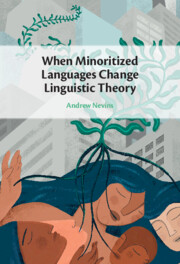Book contents
- Frontmatter
- Dedication
- Frontmatter
- Contents
- Figures
- Acknowledgments
- Abbreviations
- Map
- 1 Expanding the Canon: Minoritization in the World and in Linguistic Theory
- 2 Indexical Shift in Zazaki and Uyghur
- 3 Why Ergative Case Requires Structure in Basque and Ch’ol
- 4 Closest Conjunct Agreement in Slovenian and Xhosa
- 5 Configurationality of Objects in Chichewa and Warlpiri
- 6 Partial Nasality in Maxakalí and Kaingang
- 7 Symmetric Hands in Sign Language Phonologies
- 8 Number-Encoding on Verbs in Hiaki and Chechen
- 9 Conclusion: Towards Healthy Futures in the Language Sciences
- Bibliography
- Index
7 - Symmetric Hands in Sign Language Phonologies
Published online by Cambridge University Press: 18 November 2022
- Frontmatter
- Dedication
- Frontmatter
- Contents
- Figures
- Acknowledgments
- Abbreviations
- Map
- 1 Expanding the Canon: Minoritization in the World and in Linguistic Theory
- 2 Indexical Shift in Zazaki and Uyghur
- 3 Why Ergative Case Requires Structure in Basque and Ch’ol
- 4 Closest Conjunct Agreement in Slovenian and Xhosa
- 5 Configurationality of Objects in Chichewa and Warlpiri
- 6 Partial Nasality in Maxakalí and Kaingang
- 7 Symmetric Hands in Sign Language Phonologies
- 8 Number-Encoding on Verbs in Hiaki and Chechen
- 9 Conclusion: Towards Healthy Futures in the Language Sciences
- Bibliography
- Index
Summary
This chapter looks at sociolinguistic variation (resulting from sociohistorical factors that differentiate people into groups) and how it interfaces with phonological differences. The specific phonological difference under study is the use of the two hands versus the use of only one as an aspect of sublexical structure (i.e., as a phonological feature) in individual signs, and their overall patterning throughout the lexicon and morphophonology. We examine how Black ASL demonstrates the distribution of allophony in two-handed vs. one-handed lexical variants of signs.
- Type
- Chapter
- Information
- When Minoritized Languages Change Linguistic Theory , pp. 99 - 136Publisher: Cambridge University PressPrint publication year: 2022

